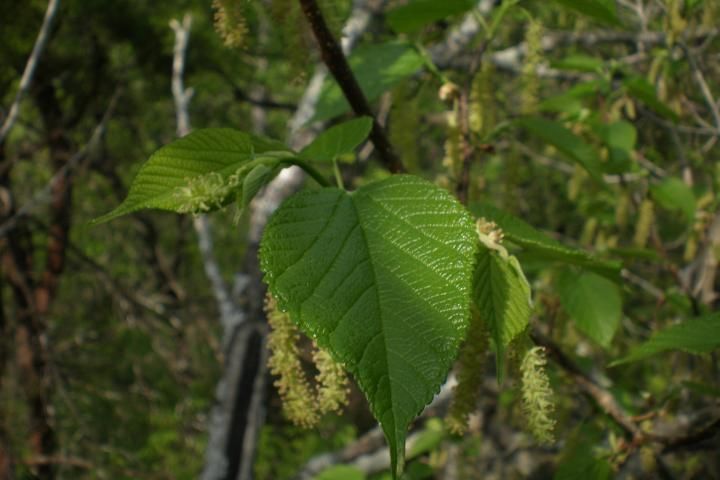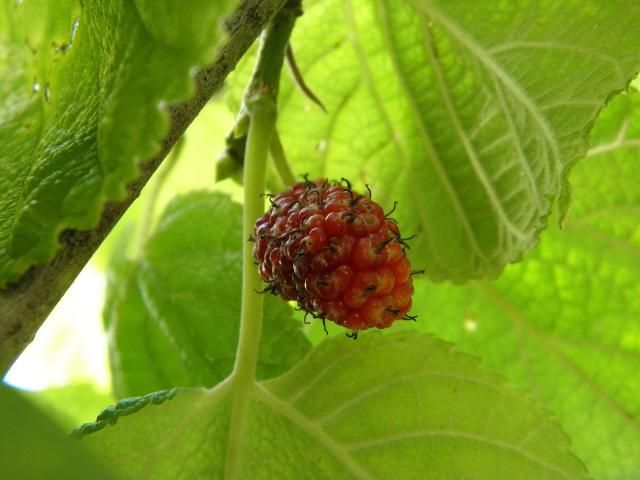Family
Moraceae, mulberry family.
Genus
Morus is the Latin word for mulberry.
Species
The species name, rubra, comes from the Latin word for "red" and refers to the red fruits of this tree.
Common Name
Red Mulberry
The word "mulberry" has an interesting etymological evolution. The Old High German word for berry, beri, was combined with the Latin word morus to make the word múlbere. This word (múlbere) then morphed into the German name Maulbeer, which then transformed into the Dutch word moerbezie, and eventually the English word mulberry.
Description
This native deciduous tree is generally found in the moist soils of mesic hardwood forests, floodplains, and other moist sites from south Florida, west to Texas, north to Minnesota and the extreme southern portion of Ontario, Canada, and east to the Mid-Atlantic states. Red mulberry grows well in open locations under full exposure to the sun. It reaches heights of 15 to 70 feet, growing larger in its northern ranges. Its leaves are simple, alternately arranged, and grow between 2 to 8 inches long. Mulberry leaves are generally heart-shaped, but they can have anywhere from 0 to 3 lobes. The leaves on young trees and new branches are particularly variable. Leaf margins are saw toothed but are soft to the touch. The topsides of the leaves are dull green with a rough texture, while the undersides are pubescent or hairy, with a fuzzy, soft feel. Bark is brown and splits into scaly plates. The greenish to white inconspicuous flowers appear in clusters in the spring, with male and female flowers occurring either on the same tree or separate trees. The red to dark purple berries ripen in late spring, are between 1 and 1¼ inch long, and are an aggregate of drupelets or are made up of several tiny, one-seeded fruits.

Credit: Mary Tricia, CC BY-NC 2.0
Allergen
Male trees are extremely allergenic and should be avoided, while female trees cause few or no allergies. The pollen from members of the Morus genus can cause allergies ranging from hay fever to asthma.
Storm Tolerance
This tree has a medium to low resistance to wind.
Applications
Commercial/Practical
Though the wood of mulberry is relatively weak, it has been used in the crafting of furniture, fence posts, and farm tools. Fruits of red mulberry are used to make preserves, jams, pies, and other sweets.
Cultural
The earliest recorded use of mulberry fruits was by the De Soto expedition in the mid 1500s, who observed the Muskogee Indians consuming dried fruits. During the winter, the Iroquois mashed, dried, and stored mulberry berries, and then added them to water to make warm sauces that they sometimes mixed into cornbread. The Cherokee made sweet dumplings by mixing cornmeal and sugar with the berries. In addition to eating the berries, the Timucua of northeast Florida used the leaves, twigs, and berries to make dyes, and Seminoles used the branches to make bows. Eventually, European settlers used the fruits to make pies, preserves, and other sweets. Trees were widely planted for the production of fruit as a food source and as feed for livestock. The wood from Mulberry trees has also been used in the construction of furniture, boats, and tubs.
Horticultural
Red mulberry should be used as a background tree and planted away from the house to avoid the potentially unpleasant odor of rotting fruit after the berries ripen and fall to the ground. However, it is unlikely any fruit will be left to rot, since most people and animals eat them long before they reach that point!
Medicinal
Many tribes used different parts of mulberry to treat various sicknesses. For instance, the Alabama and Creek Indians treated urinary tract issues using an extract made from mulberry root. The Rappahannock took the sap and rubbed it over skin to treat ringworm, and the Cherokee steeped the bark and ingested the liquid to loosen stool and get rid of intestinal worms. The Meskwaki used the root bark as a cure for a wide range of ills.
Wildlife
Mulberry is palatable to humans and wildlife. Berries are chiefly eaten by birds, most likely due to their ability to access them first. However, mammals such as squirrels, opossums, and raccoons also relish these sweet berries.
References
Austin, D. F. 2004. Florida ethnobotany. Boca Raton, FL: CRC Press.
Borror, D. J. 1988. Dictionary of root words and combining forms. Mountain View, CA: Mayfield Publishing Company.
Burns, R. M., B. H. Honkala, and coordinators. 1990. Silvics of North America: Volume 2. hardwoods (Vol. 2). Washington, D.C.: U.S. Government Printing Office.
Duryea, M. and E. Kampf. 2007. Wind and trees: Lessons learned from hurricanes (FOR118). Gainesville, FL: UF-IFAS Florida Cooperative Extension Service. Retrieved from https://edis.ifas.ufl.edu/fr173
Godfrey, R. K. 1988. Trees, shrubs, and woody vines of Northern Florida and adjacent Georgia and Alabama. Athens, GA: The University of Georgia Press.
Haehle, R. J. and J. Brookwell. 2004. Native Florida plants: Low-maintenance landscaping and gardening. Lanham, MD: Taylor Trade Publishing.
Kurz, H. and R. K. Godfrey. 1993. Trees of Northern Florida. Gainesville, FL: University Press of Florida.
Little, E. L. 2005. National Audubon Society field guide to trees, Eastern region. New York, NY: Alfred A. Knopf, Inc.
Nelson, G. 1994. The trees of Florida: A reference and field guide. Sarasota, FL: Pineapple Press.
Ogren, T. L. 2000. Allergy-free gardening: The revolutionary guide to healthy landscaping. Berkeley, CA: Ten Speed Press.
Peattie, D. C. 1977. A natural history of trees of eastern and central North America. Boston, MA: Houghton Mifflin Company.
USDA Natural Resources Conservation Service. (n.d.). PLANTS database. Retrieved from http://plants.usda.gov/index.html
